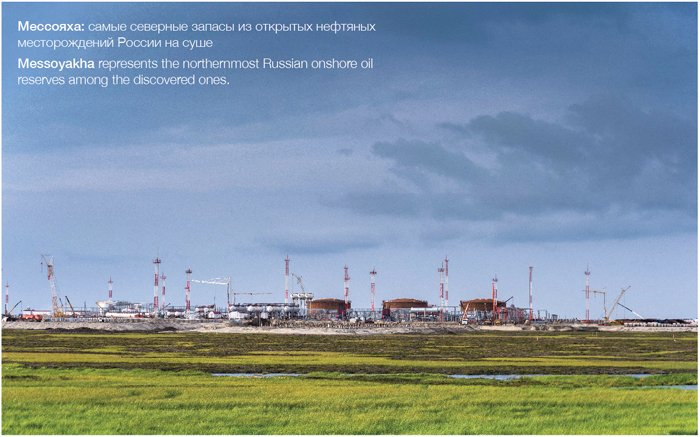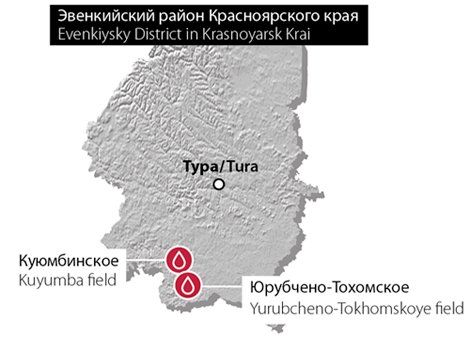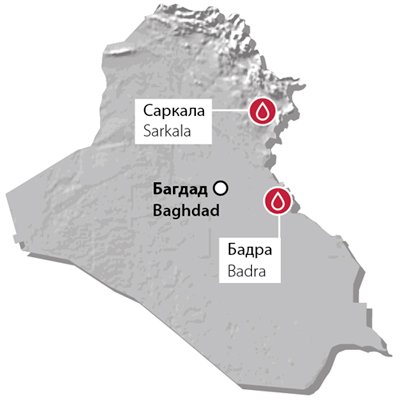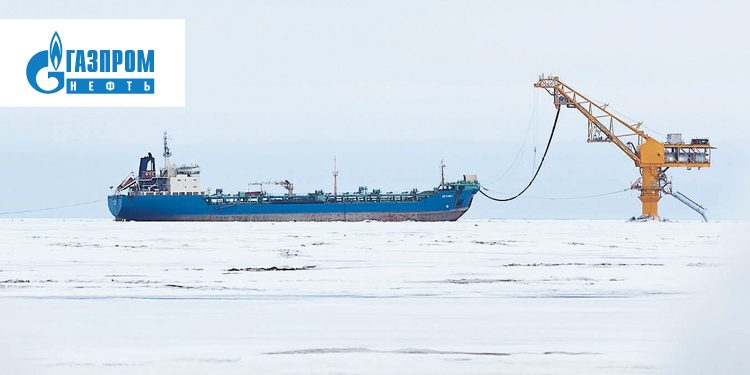Gazprom Neft: Production Projects
The development of new oil reservoirs is a priority for a company that claims leadership within their industry. Gazprom Neft develops new reservoirs on a project format basis. The company portfolio includes eight new projects. Each of these projects has a unique geographic, geological or climatic features. According to the company’s current strategy, projects that were commissioned during the last decade are planned to provide half of Gazprom Neft’s total output by 2020.
Novy Port
The Novoportovskoye oil and gas-condensate field is located at southeastern part of the Yamal Peninsula, the field lies 250 km north of Nadym and 30 km from the Gulf of Ob. Recoverable reserves are estimated at over 250 million tons of oil and condensate, and over 320 billion cubic meters of gas. Field pilot operations started in 2012. The new oil grade produced at the Novoportovskoye field, called Novy Port, belongs to light crudes (sulfur content is about 0.1%) and is not only better than Russian Urals oil crude blend, but also better than the Brent benchmark.

A few options were considered when it came to the Novoportovskoye field crude oil transportation system. Initially the only way to transport the oil to the mainland was by winter roads to the Payuta railway station, which is located 200 km from the field. Crude oil shipment at Cape Kamenny, at the Gulf of Ob, was chosen as the optimal solution. It required the construction of over 100 km long oil pipeline. In 2014 the oil was delivered to а tanker for overseas transportation to Europe, from Novy Port, for the first time. The first winter oil shipment sailed in February 2015. The tanker was escorted by a nuclear icebreaker via the Northern Sea Route.
Year-round crude oil shipments are sent from the Arctic Gates oil loading terminal. The terminal is equipped with a two-level emergency shutdown systems that provide zero discharge which prevent discharge of any foreign matters to the water. This unique structure is designed for operation in extreme natural climatic conditions when the ambient temperature drops below -50 oC and the ice thickness can exceed 2m.
Messoyakha
The Messoyakha fields cluster (Eastern and Western fields) are the northernmost cluster of all the onshore Russian developed fields. The cluster is located at the Gydan Peninsula, 340 km north of Novy Urengoi. The license for the Use of Subsurface Resources belongs to Messoyakhaneftegas controlled by Gazprom Neft and Rosneft on a parity basis. The proven geological resources of the Messoyakha cluster are, as of today, calculated at over 470 million tons of oil and condensate and about 188 billion cubic meters of natural oil and associated gas. These fields can be classified as unique.
The fields were not in demand for a few decades due to lack of oil and gas transport infrastructure in this area. This changed in 2011 after the construction, by Transneft, of the new Zapolyarie – Purpe pipeline system. Today, the construction of East-Messoyakha’s infrastructure construction is at its final stage: development of cluster pads, commissioning the central production facility, gas turbine power plant and custody transfer point. In May 2016 a 98 km long oil pressure pipeline was constructed. The line leads to head oil pumping station of the Zapolyarie – Purpe main oil pipeline. The field is to be put in operation in autumn 2016. The first oil portion from Messoyakha to Transneft’s system is also planned in autumn.

Arcticgas
The project incorporates a cluster of fields in the north of Yamal-Nenets Autonomous District: Samburgskoye, Urengoiskoye, East-Urengoiskoye and North-Esetinskoe fields, and Yaro-Yakhinsky, Evo-Yakhinsky, and Severo-Tchaselsky licensed blocks. These fields are developed by Arcticgas, a joint venture of NOVATEK and Gazprom Neft.

Commercial production of field began in April 2012 by commissioning of Samburgskoye field. Today the Samburgskoye, Urengoiskoye and Yaro-Yakhinskoye fields production output has reached the designed value. The main products of these fields are gas and gas condensate. The Samburgskoye field output is about 7 billion cubic meters of natural gas and 0.9 million tons of gas condensate per year.
Natural gas is supplied from the field to the Unified Gas Supply System. Gas condensate is supplied via a gas condensate pipeline to the Yurkharovo-Purovsky Gas Condensate Conversion Plant. The Samburgskoye field development also provides development of oil reserves to be connected with Zapolyarie-Purpe oil pipeline.

Chona
The project covers three licensed blocks – Ignyalinsky, Tymputchikansky and Vakunaisky. The fields are located at the border of the Irkutsk Region and the Sakha Republic, 100 km from the East Siberia – Pacific Ocean pipeline (ESPO). Gazpromneft-Angara, a Gazprom Neft subsidiary, is licensed for the development of these fields. The estimated C1 + C2 category field reserves as of January 1, 2016 are 210 million tons of oil and 270 billion cubic meters of gas.
The Chona Project fields feature a complex geological structure that requires the application of non-standard geological exploration methods. It was here where the company first used 3D UniQ technology for the high-resolution seismic operations and the applied method of ination of optimal development method. The fields planned commissioning date is 2021.
Kuyumba
The Kuyumba field cluster is one of the largest projects in Gazprom Neft portfolio. The cluster covers Kuyumba, Tersko-Kamovsky, Kordinsky, Abrakupchinsky and Podporozhny licensed blocks that are located in the Evenkiysky District in Krasnoyarsk Krai. The licenses for these fields belong to Slavneft-Krasnoyarskneftegas, a joint venture co-owned by Gazprom Neft and Rosneft. The largest fields of the project are the Kuyumba and Yurubcheno-Tokhomskoye fields (Tersko-Kamovsky licensed block) with C1 and C2 reserves of over 500 million tons.

The Kuyumba field was discovered in 1973, but it was delayed for a long time due to lack of oil transport infrastructure. The East-Siberia – Pacific Ocean pipeline system startup and Transneft’s decision to construct the 700 km long Kuyumba – Taishet pipeline branch have turned the tide. Activities on the production infrastructure and preparation of the hydrocarbon reservoirs for development have been performed at the Kuyumba field since 2010. Complete commissioning is planned for 2018.

Badra
The Badra oil field located at Wasit Governorate in Eastern Iraq is one of the main foreign Gazprom Neft projects. Badra’s geological reserves are estimated at 3 billion barrels (about 400 million tons) of Basrah Light oil. Gazprom Neft owns a 30 percent share of the project and performs the duties of operator.
The Badra field features one of the most complicated geological structures among the fields of Iraq. The field infrastructure development process was accompanied by serious difficulties: the war between Iraq and Iran was running through the Badra area and the whole area was mine-infested. The rights for the development of this field were gained in December 2009. Within four years, construction of the first stage of the central production facility and field was connected to the Iraq main pipeline system via a 165 km long pipeline. In May 2014 commercial oil production started. August 2014 was marked by the start of commercial crude oil production and shipment to the export terminal in Basra (Persian Gulf).
For today Badra is a technologically advanced asset.
The construction of the integrated oil and APG processing plant at the field is in its final stage. The development of the project featured the first use of 3D modeling methods by Gazprom Neft. The execution of this project will provide an effective APG utilization level up to 99%. There is also a plan to build a sulfur granulation unit at the field in order to provide a maximal level of hydrogen sulfide utilization.
Garmian
Sarkala field, part of Garmian cluster, is another Gazprom Neft project in Iraq. The field is located in Iraqi Kurdistan. According to information available at the beginning of 2016, the field reserves are about 50 million tons of oil. The field development is performed by a joint venture owned by Gazprom Neft (40%) and by the Canadian company WesternZagros Resources (40%). The final part of the venture is controlled by the Kurdistan government. Gazprom Neft Middle East, a Gazprom Neft subsidiary, has taken the Sarkala field under operating control in early 2016.
The first oil at the Garmian cluster was produced in 2011, and 2015 marked the start of commercial crude oil shipments. The follow-up exploration and preparation for large scale development is being performed today at the cluster. In Kurdistan Gazprom Neft used a number of new technologies. For example, the wireless sensors for seismic surveys have been used here. This method became a base for green seismic technology aimed at reducing the deforestation during operations in forest areas.











